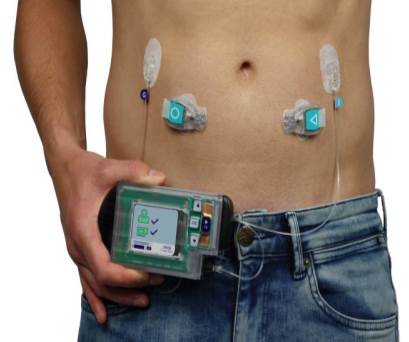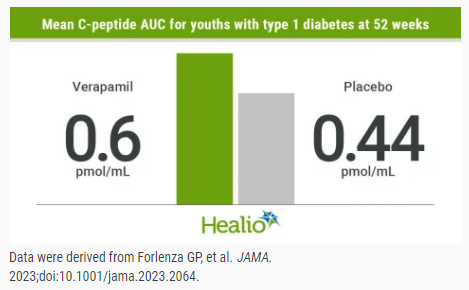Scientists use implanted glucose-run fuel cell to power insulin release by Nick Paul Taylor for MedTechDive.com, 29 March 2023.
 There is a need for better ways to power medical implants. Devices either have a battery that gradually runs down and eventually needs replacing in another procedure, or use rechargeable batteries that are powered wirelessly. Neither option is perfect. Ideally, batteries would neither need replacing nor charging manually. Rather, they would be self-sustaining. Researchers at ETH Zurich saw a way to realize that idea.
There is a need for better ways to power medical implants. Devices either have a battery that gradually runs down and eventually needs replacing in another procedure, or use rechargeable batteries that are powered wirelessly. Neither option is perfect. Ideally, batteries would neither need replacing nor charging manually. Rather, they would be self-sustaining. Researchers at ETH Zurich saw a way to realize that idea.
“Many people, especially in the Western industrialized nations, consume more carbohydrates than they need in everyday life,” ETH Zurich’s Martin Fussenegger said. “This gave us the idea of using this excess metabolic energy to produce electricity to power biomedical devices.”
Fussenegger and his collaborators realized the vision, at least in mice, by using a copper-containing, conductively tuned 3D carbon nanotube composite. When the device detects hyperglycemia, it converts glucose into gluconic acid and a proton to generate electricity. The electricity is sufficient to power a small medical device, in this case, a capsule containing artificial beta cells.
Because the fuel cell only generates electricity during hyperglycemia, the device automatically stops releasing insulin once blood sugar levels have returned to normal. The fuel cell also made enough energy to support communication with external devices, such as smartphones, and enable doctors to remotely change the settings.
The device remains a prototype and the researchers see “a long, uncertain road to market maturity.” If commercialized, the technology could disrupt continuous glucose monitor and insulin pump markets fought over by companies such as Abbott and Medtronic.
Read more: Scientists use implanted glucose-run fuel cell to power insulin release
Artificial pancreas from Dutch Inreda Diabetes likely to be on the market in 2024 by Elcke Vels for InnovationOrigins.com,18 May 2022.
 The artificial pancreas (AP®) from medtech company Inreda Diabetes in the Dutch city of Twente, makes it possible for diabetes patients to regulate their blood sugar completely automatically for the first time. More than one hundred patients are currently fitted with the device. But there is also good news for diabetic patients in the Netherlands who have not had the opportunity to use it so far: “I expect that the device will be available on a large scale in 2024”, says the inventor Robin Koops.
The artificial pancreas (AP®) from medtech company Inreda Diabetes in the Dutch city of Twente, makes it possible for diabetes patients to regulate their blood sugar completely automatically for the first time. More than one hundred patients are currently fitted with the device. But there is also good news for diabetic patients in the Netherlands who have not had the opportunity to use it so far: “I expect that the device will be available on a large scale in 2024”, says the inventor Robin Koops.
Inreda obtained the CE marking in 2020, which in principle means that the company is already authorized to market the artificial pancreas. Since 2020, the first projects with the AP have been running with the Dutch health insurance companies Menzis and CZ. In several hospitals, mainly in the east and south of the Netherlands, 125 diabetic patients have since started the AP treatment. “Meanwhile, we have been following these patients for over a year and a half and keeping track of various data. Among other things, on how the device functions and on how it contributes to the quality of life,” Koops explains.
Read more: Artificial pancreas from Dutch Inreda Diabetic likely to be on the market in 2024
A small biotech’s shares double on diabetes drug results by Kristin Jensen for BioPharmaDive.com, 29 March 2023.
 Biomea Fusion’s market value doubled after initial research on the biotech’s experimental diabetes drug surpassed expectations. Trial participants who took the drug on an empty stomach benefited more from the treatment, with 89% responding and 56% achieving a reduction of at least 1% in a blood sugar measurement known as A1C. The company had previously told analysts that a reduction of about 0.3% would be considered a positive result.
Biomea Fusion’s market value doubled after initial research on the biotech’s experimental diabetes drug surpassed expectations. Trial participants who took the drug on an empty stomach benefited more from the treatment, with 89% responding and 56% achieving a reduction of at least 1% in a blood sugar measurement known as A1C. The company had previously told analysts that a reduction of about 0.3% would be considered a positive result.
Biomea is continuing the Phase 2 study, testing higher doses in different groups of patients. The company also plans to expand its research to include dosing periods longer than four weeks and will explore whether the drug can help other patients with diabetes, including Type 1 patients.
BMF-219 is designed to block a protein known as menin that researchers believe has a negative effect on beta cells that help the body produce insulin and control blood sugar. The goal “is to deliver the first disease-modifying treatment for patients with diabetes by addressing the root biological cause of the disease and its inevitable progression: the loss of insulin-producing beta cells,” Biomea CEO Thomas Butler said in the company’s press release Tuesday.
Read more: A small biotech’s shares double on diabetes drug results
Bigfoot Biomedical Acquires Reinforcement Learning Algorithm for Insulin Titration Developed at McGill University reported by BusinessWire.com, 30 March 2023.
 Bigfoot Biomedical (Bigfoot), a leader in developing intelligent connected injection support systems, today announced the acquisition of a reinforcement learning algorithm for the titration of insulin settings developed at McGill University. The algorithm is designed to observe how well people with insulin-requiring diabetes respond to a particular insulin dose, and provide a recommended adjustment based on their body’s response. It’s built to get smarter over time and to support healthcare professionals (HCPs) in improving diabetes care by helping their patients determine how much insulin to take and when.
Bigfoot Biomedical (Bigfoot), a leader in developing intelligent connected injection support systems, today announced the acquisition of a reinforcement learning algorithm for the titration of insulin settings developed at McGill University. The algorithm is designed to observe how well people with insulin-requiring diabetes respond to a particular insulin dose, and provide a recommended adjustment based on their body’s response. It’s built to get smarter over time and to support healthcare professionals (HCPs) in improving diabetes care by helping their patients determine how much insulin to take and when.
McGill University conducted an in-silico retrospective study that applied the university’s algorithm to Bigfoot Unity user data from 20 patients to evaluate the algorithm’s ability to predict appropriate insulin dosing adjustments. Study results demonstrated the algorithm accurately predicted how the patient’s HCP adjusted their insulin dose.
“The retrospective study performed by the McGill University team demonstrates strong promise for the algorithm’s ability to help further simplify diabetes management,” said Jeffrey Brewer, CEO of Bigfoot Biomedical. “We look forward to the responsibility of taking the necessary next steps to bring their innovation to the diabetes community, including research and development to incorporate the algorithm into the Bigfoot Unity platform and collaborating with the FDA on the appropriate regulatory pathway.”
Read more: Bigfoot Biomedical Acquires Reinforcement Learning Algorithm
Verapamil partially preserves C-peptide levels among youths with type 1 diabetes by Michael Monostra for Healio.com/endocrinology, 29 March 2023.
 Once-daily oral verapamil may help preserve stimulated C-peptide secretion for children and adolescents with type 1 diabetes, according to a study published in JAMA.
Once-daily oral verapamil may help preserve stimulated C-peptide secretion for children and adolescents with type 1 diabetes, according to a study published in JAMA.
“This finding of a beneficial effect of verapamil has important clinical implications,” Roy W. Beck, MD, PhD, president and medical director of the Jaeb Center for Health Research Foundation in Tampa, Florida, said. “Currently, outside of clinical trials, there are no treatments being prescribed to try to preserve beta cells in newly diagnosed type 1 diabetes. Maintenance of even modest residual beta-cell function helps a person with type 1 diabetes better control hyperglycemia, and importantly, it reduces the risk of hypoglycemia. Higher C-peptide levels also are associated with lower risk of diabetes-related vascular complications and, therefore, is a desirable goal.”
Read more: Verapamil partially preserves C-peptide levels among youths with type 1 diabetes
How much diabetes medication actually costs by Quinn Everts for MedicalEconomics.com, 30 March 2023. “Affordability of prescribed medication in persons with diabetes remains a significant challenge for many Americans,” the study concluded.
 A poster presented at the APhA Annual Meeting and Exposition from researchers Joshua Devine, PharmD, PhD; Dooyoung Lim; Amy Lugo; and Joel F. Farley, PhD, FAPhA, hoped to highlight just how exorbitant OOP spending for people with diabetes has become. “The objective of this study was to examine out-of-pocket (OOP) spending for antidiabetic medication and evaluate whether Americans reach catastrophic spending levels for these drugs during the year,” the study said. “We also considered factors associated with the likelihood of reaching catastrophic spending for prescription medication.”
A poster presented at the APhA Annual Meeting and Exposition from researchers Joshua Devine, PharmD, PhD; Dooyoung Lim; Amy Lugo; and Joel F. Farley, PhD, FAPhA, hoped to highlight just how exorbitant OOP spending for people with diabetes has become. “The objective of this study was to examine out-of-pocket (OOP) spending for antidiabetic medication and evaluate whether Americans reach catastrophic spending levels for these drugs during the year,” the study said. “We also considered factors associated with the likelihood of reaching catastrophic spending for prescription medication.”
The threshold for catastrophic spending levels, according to the study, is reached when “greater than 40 percent of a household’s non-subsistence income {is spent} on health care payments.” “An estimated 3 million Americans (10.3%) reported OOP spending for antidiabetic drugs that reached catastrophic spending in 2020. This figure climbed to 4.9 million (16.5%) when considering OOP spend for all prescription medicine filled throughout the year.”
Even for many patients with diabetes who didn’t reach catastrophic levels, the burden of OOP payments was still felt. On a more personal scale, “Annual OOP payments per capita for all prescription drugs among persons with diabetes were $436 and antidiabetic drugs accounted for 41% of this total or $178 per capita.”
Read more: How much diabetes medication actually costs
Prescription-drug middlemen face mounting pressure from federal government, states by Elanor Laise for MarketWatch-com.cdn.ampproject.org, 31 March 2023.
 Political and legal troubles are piling up around the companies that act as influential middlemen in the U.S. prescription-drug system. Pharmacy benefit managers, which manage prescription-drug benefits on behalf of insurers, large employers and other payers, were the focus of a Senate Finance Committee hearing Thursday scrutinizing their impact on the prices patients pay at the pharmacy counter and the costs to government programs such as Medicare. The hearing comes just days after the Ohio attorney general filed an antitrust lawsuit alleging that some PBMs illegally drove up drug prices.
Political and legal troubles are piling up around the companies that act as influential middlemen in the U.S. prescription-drug system. Pharmacy benefit managers, which manage prescription-drug benefits on behalf of insurers, large employers and other payers, were the focus of a Senate Finance Committee hearing Thursday scrutinizing their impact on the prices patients pay at the pharmacy counter and the costs to government programs such as Medicare. The hearing comes just days after the Ohio attorney general filed an antitrust lawsuit alleging that some PBMs illegally drove up drug prices.
“It’s a heat wave” for PBMs, said Antonio Ciaccia, CEO of drug-pricing research nonprofit 46brooklyn Research, with recent days’ developments amounting to “some largely unprecedented pressure” on the industry. “People are figuring out that drug pricing is a lot more complicated than drugmakers setting prices,” he said.
As central players negotiating with drugmakers and pharmacies, PBMs can influence which drugs are prescribed to patients, patient access to medications, payment terms for pharmacies, total drug costs for insurers and how much patients ultimately pay for their drugs, researchers and regulators say. But their complex contractual relationships with insurers and other stakeholders often make it difficult for the public to understand and assess that influence, critics say, leading to calls for more transparency and regulation.
In recent years it has become apparent that “PBMs are using their data, their market power, and their know-how to keep prices high and pad their profits instead of sharing the benefits of prices they negotiate” with consumers, Senate Finance Committee chair Ron Wyden, an Oregon Democrat, said at the hearing Thursday. The industry’s practices, he said, are “having a big impact on the prices that Americans pay at pharmacy counters” nationwide.
Read more: Prescription-drug middlemen face mounting pressure from federal government
Splenda® Stevia Farm Announces Official Operation Of Its Fully Integrated US-Based Stevia Farm, Building A New American Industry by Splenda.com, 7 March 2023.
 Splenda®, the #1 low-calorie sweetener brand and its parent company, Heartland Food Products Group have officially announced the opening of Splenda Stevia Farm: the first-ever fully integrated, United States-based stevia farm.
Splenda®, the #1 low-calorie sweetener brand and its parent company, Heartland Food Products Group have officially announced the opening of Splenda Stevia Farm: the first-ever fully integrated, United States-based stevia farm.
Now fully operational in Central Florida, the Farm aims to produce superior-tasting stevia sweetener, while building an emerging US agriculture industry, and decreasing environmental impact by eliminating unnecessary CO2 emissions caused by current global stevia supply chain operations. The Farm’s agricultural operations will enable Splenda to domestically produce the best-tasting Splenda Stevia products and other Splenda-sweetened foods and beverages.
By growing higher-quality stevia plants and producing better and sweeter-tasting stevia sweeteners, we can help consumers achieve their sugar reduction goals,” said Ted Gelov, Chairman & CEO of Heartland. “Additionally, by growing stevia in the US, we are helping to build a new American agriculture industry and bring more farming jobs and economic prosperity to Central Florida with this $50MM initial investment. Until now, all stevia has been grown and processed from markets outside the US, mainly China. The approach we’ve engineered with our Splenda Stevia Farm gives US farmers an opportunity to grow and process stevia right on their own farms. Our ultimate goal is to help Americans cut unwanted sugar from their diets by 25% or more by the year 2030,” he added.
Read more: Splenda® Stevia Farm Announces Official Operation Of Its Fully Integrated US-Based Stevia Farm


PBM’s account for more healthcare costs than most of the medication manufacturers combined. I watched it as plan sponsor. I had a group of 1,400 teachers. It cost us $9.98 per person per year. Around 168K to be our PBM. The last year I administrated the plan was were rebate $6,500. Hmm $6,500 on medication costs of totaling 1.2 million annually?
Rebates of 0.54% They could not give us an accounting. I mean when I contacted one of the companies and asked how much we were charged for insulin. The total was over 41K. They said our medications were written down by an average of 35%.
If that was true, they were not doing a very decent job. Could we the employer go on our own negotiate with half a dozen manufacturers and like have done no worse.